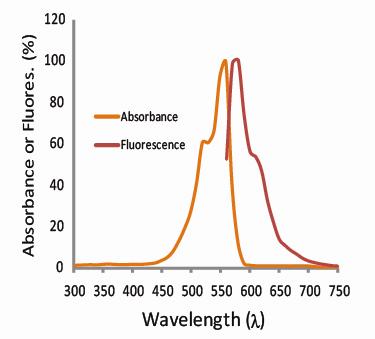
About Acti-stain™
The Acti-stain™ line of fluorescent phalloidins has been developed with an emphasis on creating exceptionally bright and stable probes at an economical price. Side-by-side comparisons with leading competing products demonstrate that you will enjoy savings while not sacrificing the quality of the stain when switching to an Acti-stain™ probe. Additionally, these probes are compatible with popular filter sets such as FITC, TRITC and Cy5. The combination of in-house manufacturing, stringent quality control and convenient packaging provides a great value. Give them a try and see for yourself.
Product Uses Include
- Stain F-actin in fixed cells
- Stabilize actin filaments in vitro
- Visualize actin filaments in vitro
Actin staining is very useful in determining the structure and function of the cytoskeleton in living and fixed cells. The actin cytoskeleton is a very dynamic and labile structure in the living cell, but it can be fixed with paraformaldehyde prior to probing or staining for actin structures.
Acti-stain™ 488 phalloidin
Cat. # PHDG1

Acti-stain™ 555 phalloidin
Cat. # PHDH1

Acti-stain™ 670 phalloidin
Cat. # PHDN1

Swiss 3T3 cell stained with anti-vinculin (red), Dapi (blue nucleus) and F-actin is stained with Acti-stain™ 488 (green F-actin, Cat.# PHDG1).
Swiss 3T3 cell with activated Rho, nucleus is stained with Dapi (blue) and F-actin is stained with Acti-stain™ 555 (red F-actin, Cat.# PHDH1).
Mitotic Swiss 3T3 cell, F-actin stained with Acti-stain™ 670 (far-red, Cat. # PHDN1), nuclear DNA stained with Dapi (blue).
Specifications:
Figure 2. Emission and excitation scans for Acti-stain™ phalloidins



Absorbance and fluorescence scan of Acti-stain™ 488. Labeled phalloidin was diluted into methanol and its absorbance and excitation spectra were scanned between 350-750 and 500-750 nm, respectively. Absorbance peaks at 500 nm and fluorescence at 550 nm.
Absorbance and fluorescence scan of Acti-stain™ 555. Labeled phalloidin was diluted into methanol and its absorbance and excitation spectra were scanned between 300-750 and 560-750 nm, respectively. Absorbance peaks at 560 nm and fluorescence at 575 nm.
Absorbance and fluorescence scan of Acti-stain™ 670. Labeled phalloidin was diluted into methanol and its absorbance and excitation spectra were scanned between 300-750 and 600-750 nm, respectively. Absorbance peaks at 625 nm and fluorescence at 675 nm.
Acti-stain phalloidins are the most well characterized phalloidins available. Tabe 1 describes their brightness, photostability, background and affinity constants to F-actin. Compare these performance characteristics to other fluorescent phalloidins and you will see the advantages of using Acti-stain™ for your actin staining requirements.
Table 1. Biochemical characteristics of fluorescent phalloidins
| Conjugate | Cat.# | Wavelengths (Ex/Em) | Brightness (AFU*) | Stability to photobleaching(half life in seconds**) | Background (% of total AFU at 100nM**) | Affinity (Kd in nanomolar) |
Fluorescein-phalloidin | na | 485/535 FITC filter set | 432 | 6 | 22 | 72 +/-12 |
Acti-stain™ 488 | PHDG1 | 485/535 FITC filter set | 832 | 57 | 5 | 55 +/-8 |
Acti-stain™ 535 | PHDR1 | 535/585 TRITC filter set | 430 | 27 | 12 | 36 +/-7 |
Acti-stain™ 555 | PHDH1 | 535/585 TRITC filter set | 551 | 46 | 16 | 63 +/-8 |
Acti-stain™ 670 | PHDN1 | 640/680 Cy5 filter set | 332 | 18 | 18 | 50 +/-12 |
* = AFU's measured by quantitative cell imaging. ** = Measured in stained Swiss 3T3 cells in the absence of antifade.
For more information about protocols to fix and stain cells click here.
Manuals and MSDS
Related Products
- Rhodamine Phalloidin (red fluorescence fixed cell F-actin stain)
- F-actin Visualization Biochem Kit™ (rhodamine)
- Actin antibody (rabbit polyclonal)
- All Actin Products page
- Activation Assays
- G-LISA™ Small G-protein Activation Assays
